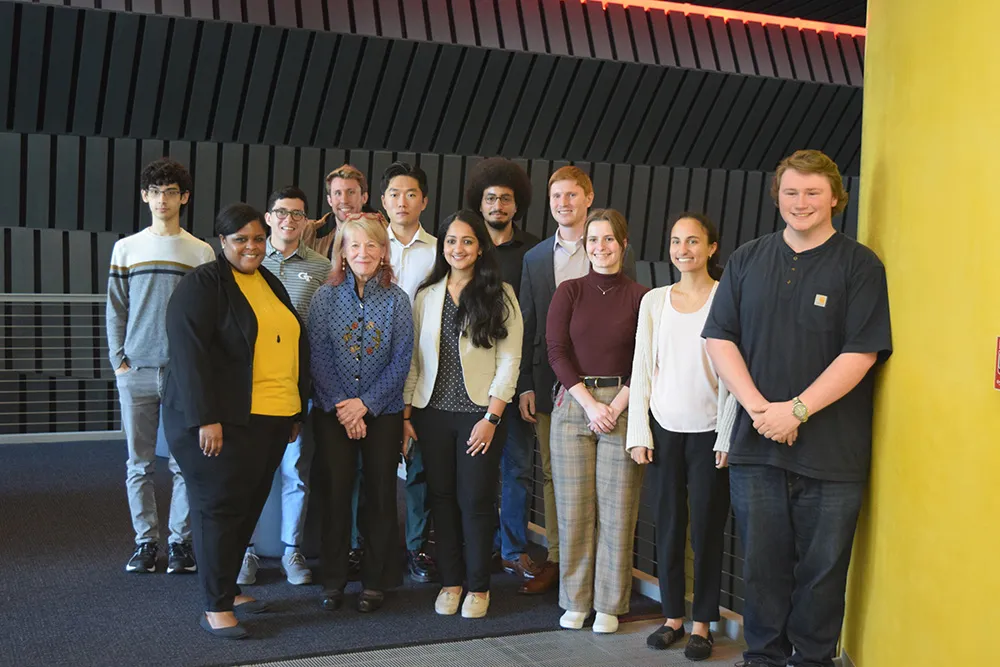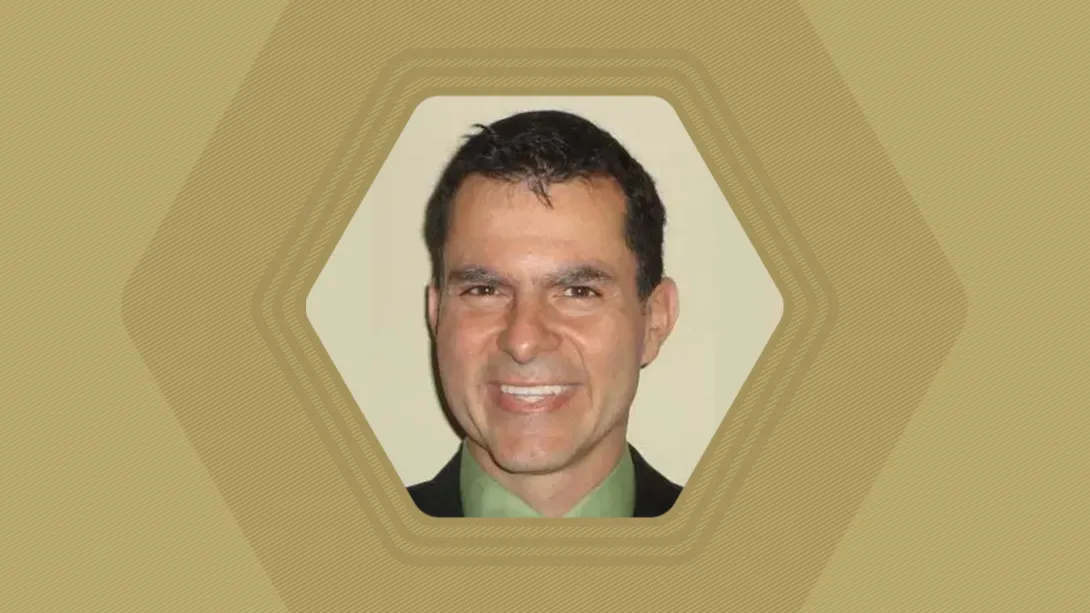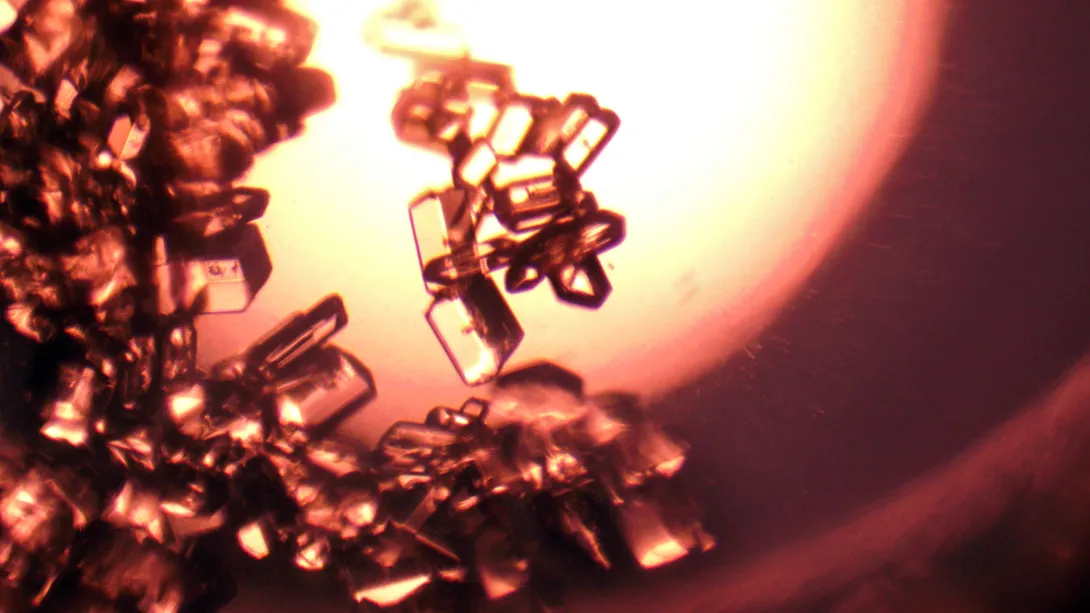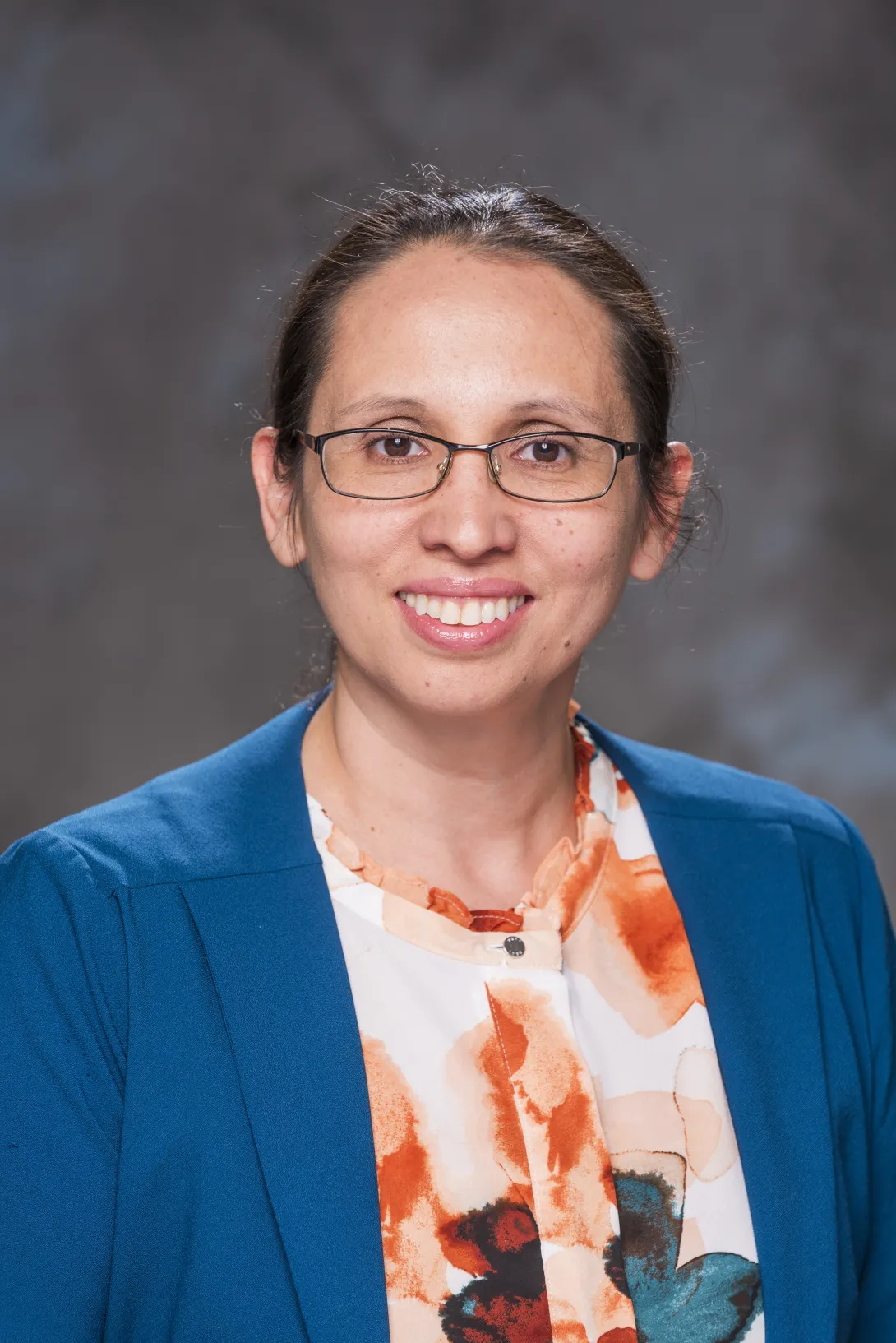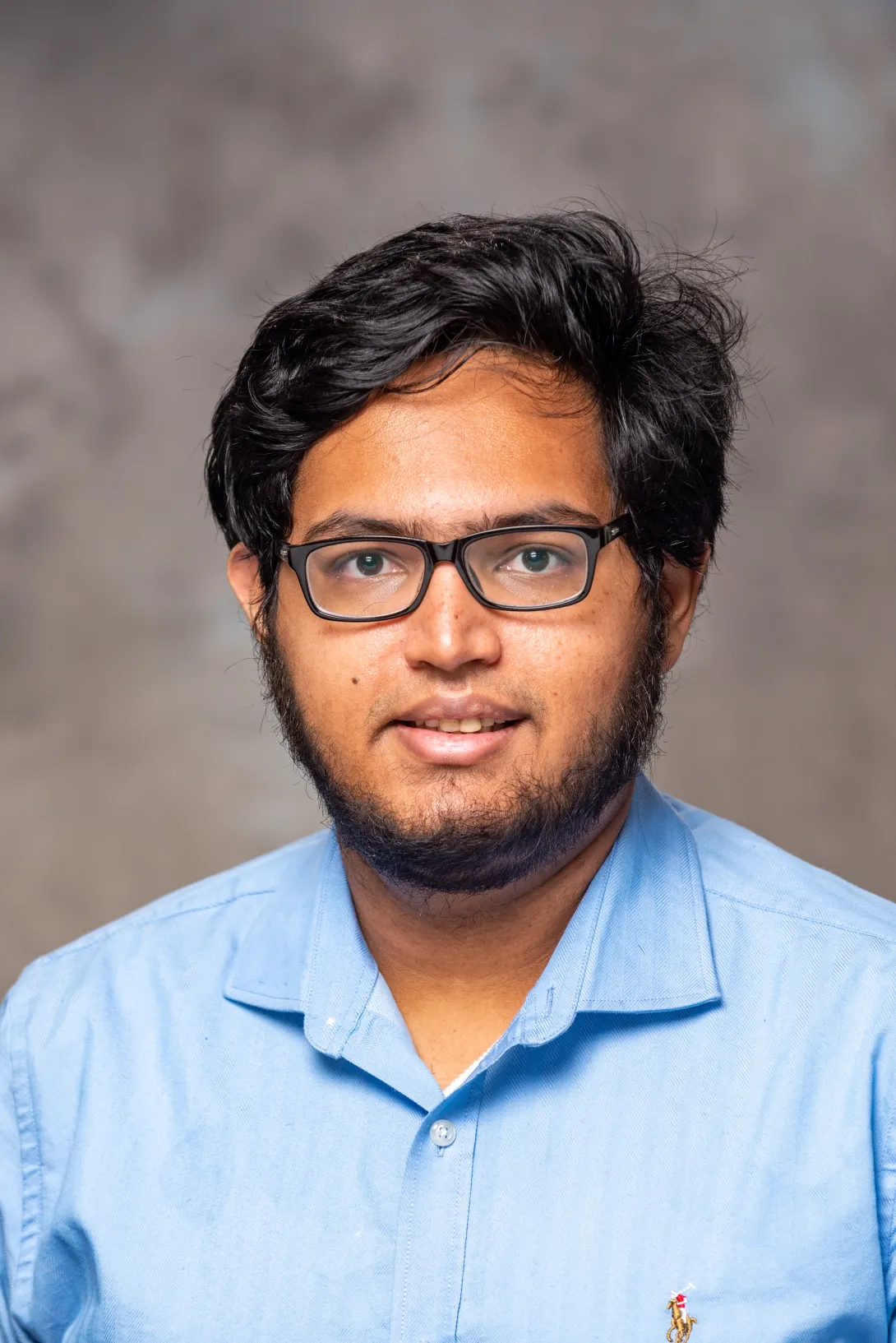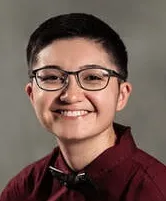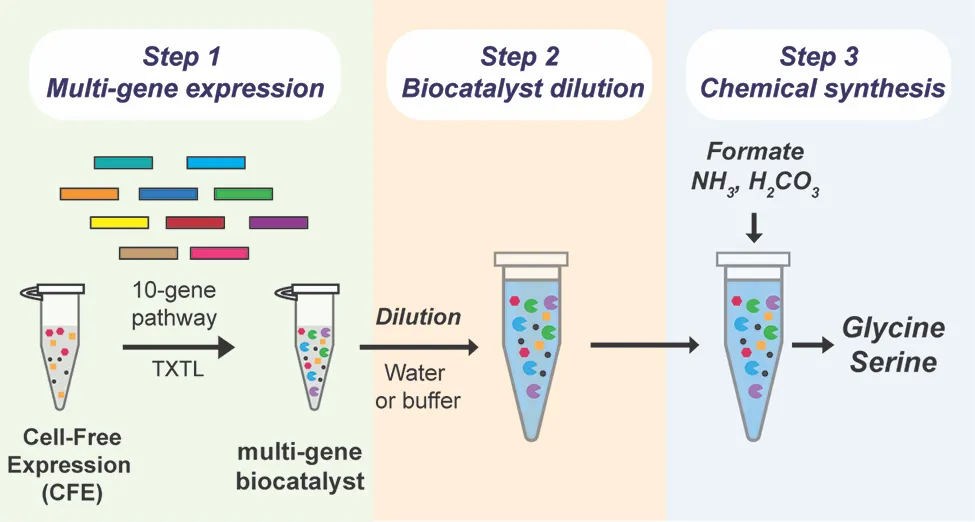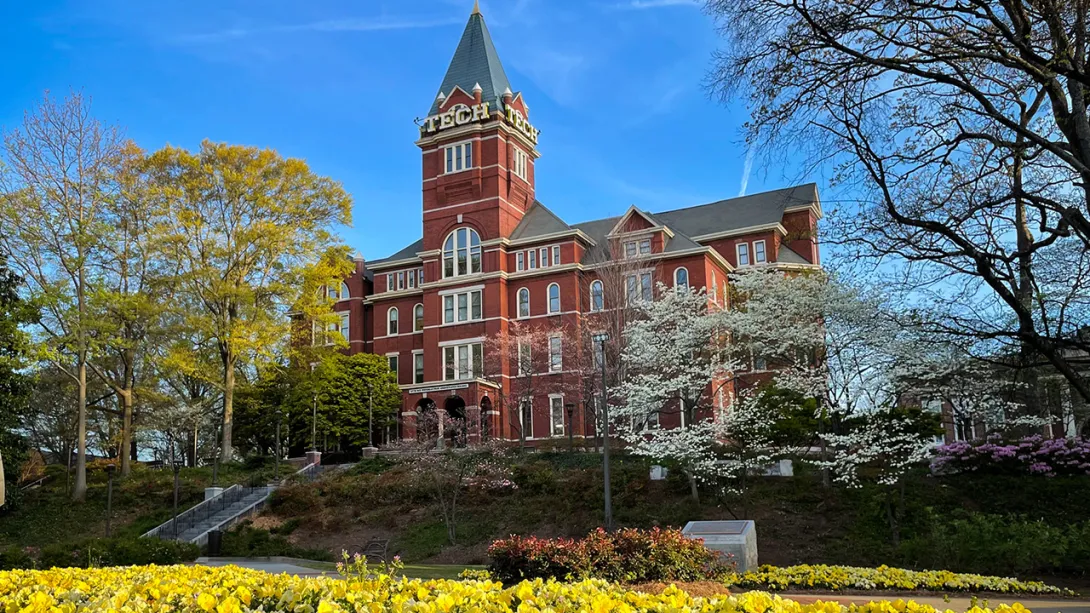Dec. 18, 2024
Johney Green Jr., M.S. ME 1993, Ph.D. ME 2000, has been chosen to serve as the new laboratory director for Savannah River National Laboratory (SRNL). A proud Yellow Jacket, Green received both his master’s and doctoral degrees in mechanical engineering from Georgia Tech and currently serves on the Strategic Energy Institute’s (SEI) External Advisory Board. He also served on the board of the George W. Woodruff School of Mechanical Engineering from 2017 to 2022.
“SRNL has truly found an exceptional leader in Johney. His vision and dedication are inspiring, and I am genuinely excited to see the remarkable contributions he will make in advancing SRNL,” said Christine Conwell, SEI interim executive director. “We look forward to his continued partnership with SEI and the positive impact he will bring to the energy community in 2025 and beyond.”
The Battelle Savannah River Alliance (SRNL’s parent organization) selected Green for this role, describing him as “a dynamic leader who brings deep, wide-ranging scientific expertise to this new position.”
With an annual operating budget of about $400 million, SRNL is a multiprogram national lab leading research and development for the Department of Energy’s (DOE) Offices of Environmental Management and Legacy Management and the National Nuclear Security Administration’s weapons and nonproliferation programs.
Green currently serves as associate laboratory director for mechanical and thermal engineering sciences at the National Renewable Energy Laboratory (NREL). In this position, he oversees a diverse portfolio of research programs including transportation, buildings, wind, water, geothermal, advanced manufacturing, concentrating solar power, and Arctic research. His leadership impacts a workforce of about 750 and involves managing a budget of more than $300 million.
At NREL, Green transformed the lab’s wind site into the innovative Flatirons Campus and transitioned the campus from a single-program wind research site to a multiprogram research campus that serves as the foundational experimental platform for the DOE’s Advanced Research on Integrated Energy Systems (ARIES) initiative.
"We are immensely proud to call Johney a Woodruff School alumnus. His achievements and service to Tech through advisory board engagement inspires us, and we are excited to see him step into this prestigious role at SRNL. We look forward to deepening our collaboration with him as he continues to make a powerful impact,” said Devesh Ranjan, Eugene C. Gwaltney, Jr. School Chair and professor in the Woodruff School.
Prior to his role at NREL, Green held several key leadership roles at Oak Ridge National Laboratory (ORNL). As director of the Energy and Transportation Science Division and group leader for fuels, engines, and emissions research, he managed a broad science and technology portfolio and user facilities that made significant science and engineering advances in building technologies; sustainable industrial and manufacturing processes; fuels, engines, emissions, and transportation analysis; and vehicle systems integration. While Green was the division director, ORNL developed the Additive Manufacturing Integrated Energy (AMIE) demonstration project, a model of innovative vehicle-to-grid integration technologies and next-generation manufacturing processes.
Early in his career, Green conducted combustion research to stabilize gasoline engine operation under extreme conditions. During the course of that research, he joined a team working with Ford Motor Co., seeking ways to simultaneously extend exhaust gas recirculation limits in diesel engines and reduce nitrogen oxide and particulate matter emissions. He continued this collaboration as a visiting scientist at Ford's Scientific Research Laboratory, conducting modeling and experimental research for advanced diesel engines designed for light-duty vehicles. On assignment to the DOE’s Vehicle Technologies Office, Green also served as technical coordinator for the 21st Century Truck Partnership. He also contributed to a dozen of ORNL's 150-plus top scientific discoveries.
Green was the recipient of a National GEM Consortium Master’s Fellowhip sponsored by Georgia Tech and ORNL, and he served as the National GEM Consortium chairperson from 2022-2024. He is a Fellow of the American Association for the Advancement of Science and an SAE International Fellow. He has received several awards during his career and holds two U.S. patents in combustion science.
News Contact
Priya Devarajan || SEI Communications Program Manager
Dec. 03, 2024
Tequila A.L. Harris, a professor in the George W. Woodruff School of Mechanical Engineering at Georgia Tech, leads energy and manufacturing initiatives at the Strategic Energy Institute. Her research explores the connectivity between the functionality of nano- to macro-level films, components, and systems based on their manufacture or design and their life expectancy, elucidating mechanisms by which performance or durability can be predicted. She uses both simulations and experimentation to better understand this connectivity.
By addressing complex, fundamental problems, Harris aims to make an impact on many industries, in particular energy (e.g., polymer electrolyte membrane fuel cells), flexible electronics (e.g., organic electronics), and clean energy (e.g., water), among others.
Harris has experience in developing systematic design and manufacturing methodologies for complex systems that directly involve material characterization, tooling design and analysis, computational and analytical modeling, experimentation, and system design and optimization. Currently, her research projects focus on investigating the fundamental science associated with fluid transport, materials processing, and design issues for energy/electronic/environmental systems. Below is a brief Q&A with Harris, where she discusses her research and how it influences the energy and manufacturing initiatives at Georgia Tech.
- What is your field of expertise and at what point in your life did you first become interested in this area?
In graduate school, I aimed to become a roboticist but shifted my focus after realizing I was not passionate about coding. This led me to explore manufacturing, particularly scaled manufacturing processes that transform fluids into thin films for applications in energy systems. Subsequently, my expertise is in coating science and technology and manufacturing system development.
- What questions or challenges sparked your current energy research? What are the big issues facing your research area right now?
We often ask how we can process materials more cost-effectively and create complex architectures that surpass current capabilities. In energy systems, particularly with fuel cells, reducing the number of manufacturing steps is crucial, as each additional step increases costs and complexity. As researchers, we focus on understanding the implications of minimizing these steps and how they affect the properties and performance of the final devices. My group studies these relationships to find innovative manufacturing solutions. A major challenge in the manufacture of materials lies in scaling efficiently while maintaining performance and keeping costs low enough for commercial adoption. This is a pressing issue, especially for enabling technologies such as batteries, fuel cells, and flexible electronics needed for electric vehicles, where the production volumes are on the order of billions per year.
- What interests you the most in leading the research initiative on energy and manufacturing? Why is your initiative important to the development of Georgia Tech’s energy research strategy?
What interests me most is the inherent possibility of advancing energy technologies holistically, from materials sourcing and materials production to public policy. More specifically, my interests are in understanding how we can scale the manufacture of burgeoning technologies for a variety of areas (energy, food, pharmaceuticals, packaging, and flexible electronics, among others) while reducing cost and increasing production yield. In this regard, we aim to incorporate artificial intelligence and machine learning in addition to considering limitations surrounding the production lifecycle. The challenges that exist to meet these goals cannot be done in a silo but rather as part of interdisciplinary teams who converge on specific problems. Georgia Tech is uniquely positioned to make significant impacts in the energy and manufacturing ecosystem, thanks to our robust infrastructure and expertise. With many manufacturers relocating to Georgia, particularly in the "energy belt" for EVs, batteries, and recycling facilities, Georgia Tech can serve as a crucial partner in advancing these industries and their technologies.
- What are the broader global and social benefits of the research you and your team conduct on energy and manufacturing?
The global impact of advancing manufacturing technologies is significant for processing at relevant economy of scales. To meet such demands, we cannot always rely on existing manufacturing know-how. The Harris group holds the intellectual property on innovative processes that allow for the faster fabrication of individual or multiple materials, and that exhibit higher yields and improved performance than existing methods. Improvements in manufacturing systems often result in reduced waste, which is beneficial to the overall materials development ecosystem. Another global and societal benefit is workforce development. The students on my team are well-trained in the manufacture of materials using tools that are amenable to the most advanced and scalable manufacturing platform, roll-to-roll manufacturing, with integrated coating and printing tools. This unique skill set equips our students to thrive and become leaders in their careers.
- What are your plans for engaging a wider Georgia Tech faculty pool with the broader energy community?
By leveraging the new modular pilot-scale roll-to-roll manufacturing facility that integrates slot die coating, gravure/flexography printing, and inkjet printing, I plan to continue reaching out to faculty and industrial partners to find avenues for us to collaborate on a variety of interdisciplinary projects. The goal is to create groups that can help us advance materials development more rapidly by working as a collective from the beginning, versus considering scalable manufacturing pathways as an afterthought. By bringing interdisciplinary groups (chemists, materials scientists, engineers, etc.) together early, we can more efficiently and effectively overcome traditional delays in getting materials to market or, worse, the inability to push materials to market (which is commonly known as the valley of death). This can only be achieved by dismantling barriers that hinder early collaboration. This new facility aims to foster collaborative work among stakeholders, promoting the integrated development and characterization of various materials systems and technologies, and ultimately leading to more efficient manufacturing practices.
- What are your hobbies?
I enjoy cooking and exploring my creativity in this space by combining national and international ingredients to make interesting and often delicious fusion cuisines. I also enjoy roller skating, cycling, and watching movies with my family and friends.
- Who has influenced you the most?
From a professional standpoint, my research team influences me the most. After I present them with a problem, they are encouraged and expected to think beyond our initial starting point. This ability to freely think and conceive of novel solutions sparks many new ideas on which to build future ideas. The best cases have kept me up at night, inspiring me to think about how to approach new problems and funding opportunities. I carry their experiences and challenges with me. Their influence on me is profound and is fundamentally why I am a professor.
News Contact
Priya Devarajan || SEI Communications Program Manager
Nov. 26, 2024
As head of the Department of Energy’s (DOE’s) Office of Science, the nation’s largest federal sponsor of physical sciences research, Under Secretary Geri Richmond understands the vital role of higher education in advancing U.S. science and innovation. On Monday, Nov. 18, she visited Georgia Tech with Chief of Staff in the Office of the Under Secretary for Science and Innovation Ariel Marshall, Ph.D. Chem 14, to meet with students and faculty and discuss future opportunities for collaboration.
During the visit, Richmond and Marshall toured Dr. Thomas Orlando’s electron and photo induced chemistry on surfaces lab; the Invention Studio; Dr. Akanksha Menon’s water-energy research lab; and the AI Maker Space.
Richmond also joined the Women+ in Chemistry student group for a roundtable discussion. An advocate for underrepresented groups in STEM fields, Richmond is the founding director of the Committee on the Advancement of Women Chemists (COACh). COACh is a grassroots organization dedicated to ensuring equal opportunities for all in science.
Georgia Tech’s longstanding partnership with the DOE is centered on research and technology development aimed at advancing energy systems and promoting sustainability. The Institute plays a key role in the DOE’s national initiatives, contributing to transformative work in energy efficiency, renewable energy, nuclear power, and environmental sustainability. Through joint research programs, grants, and initiatives, Georgia Tech continues to drive innovation and push the boundaries of energy solutions for a sustainable future.
Nov. 14, 2024
Georgia Tech School of Electrical and Computer Engineering (ECE) Motorola Solutions Foundation Professor Gabriel A. Rincón-Mora received the 2024 Outstanding Educator Award from the IEEE Atlanta Chapter at the annual banquet on Nov. 8.
The award recognizes a member of the Atlanta community who, through service to IEEE or other professional and technical organizations, has made an outstanding contribution to the electrotechnology profession.
Rincon-Mora, who is also a Fellow of the National Academy of Inventors, the Institute of Electrical and Electronics Engineers, and the Institution of Engineering and Technology, won for ground-breaking developments to power regulation and energy harvesting technologies, and outstanding contributions to analog microcircuit education.
Rincon-Mora has more than 25 years of service at Georgia Tech and the greater Atlanta area. He earned his M.S. in 1994 and Ph.D. in 1996 from Georgia Tech, and was inducted into Georgia Tech's Council of Outstanding Young Engineering Alumni in 2000. He worked for Texas Instruments in 1994–2003, was Adjunct Professor at ECE in 1999–2001, and has been a full-time professor at Georgia Tech since 2001.
He is a recognized authority in the semiconductor industry in power supplies and energy harvesting.
Rincon-Mora pioneered the use of positive feedback loops to accelerate the response of low-dropout regulators and hysteretic control to stabilize and accelerate the response of switching power supplies. He developed and mastered techniques for rejecting and suppressing power-supply noise, allowing cell phones, tablets, and laptops power supplies to be more accurate, occupy less space, and consume less energy.
He also developed ground-breaking switched-inductor microchips that draw power from tiny fuel cells, vibrating piezoelectric transducers, and magnetically coupled coils. He pioneered ways of amplifying the power they draw by investing pre-damping energy into the system. He similarly developed photovoltaic and thermoelectric microchip technologies that draw more power from ambient light and heat and consume less energy. With these innovations, wireless microsystems draw more power from biological and ambient sources, so they can perform more functions across longer periods.
He's taught ECE 3040 Microelectronic Circuits, ECE 3400 Analog Electronics, ECE 4430 Analog Integrated Circuits, ECE 6412 Analog IC Design, and ECE 6445 Power IC Design at Georgia Tech and professional short courses on analog, power, and energy integrated-circuit design for Intel, ON Semiconductor, Dialog Semiconductor, Cypress Semiconductor, Integrated Device Tech., Dolphin Design, RF Micro-Devices, Space & Naval Warfare Syst. Command, Toko Inc., Spyro Tech., and others.
His scholarly output includes 12 books, 8 handbooks, 4 book chapters, 44 patents, over 200 articles, 25 educational videos, and over 26 commercial power-chip products released to production.
Rincón-Mora's current research focuses on the design and development of silicon-based microchips and microsystems that draw and condition power from tiny batteries, fuel cells, magnetically coupled coils, and generators that harness ambient energy from motion, light, temperature, and radiation to supply and sustain mobile, portable, and self-sustaining devices like wireless microsensors for biomedical, consumer, industrial, and military applications.
He’s received a number of other awards for his work.
He’s been recognized with the National Hispanic in Technology Award from the Society of Hispanic Professional Engineers, Charles E. Perry Visionary Award from Florida International University, Three-Year Patent Award from Texas Instruments, Orgullo Hispano Award and Hispanic Heritage Award from Robins Air Force Base, a State of California Commendation Certificate from Lieutenant Governor Cruz M. Bustamante, and the IEEE Service Award, among many others.
News Contact
Zachary Winiecki
Nov. 13, 2024
Amino acids are essential for nearly every process in the human body. Often referred to as ‘the building blocks of life,’ they are also critical for commercial use in products ranging from pharmaceuticals and dietary supplements, to cosmetics, animal feed, and industrial chemicals.
And while our bodies naturally make amino acids, manufacturing them for commercial use can be costly — and that process often emits greenhouse gasses like carbon dioxide (CO2).
In a landmark study, a team of researchers has created a first-of-its kind methodology for synthesizing amino acids that uses more carbon than it emits. The research also makes strides toward making the system cost-effective and scalable for commercial use.
“To our knowledge, it’s the first time anyone has synthesized amino acids in a carbon-negative way using this type of biocatalyst,” says lead corresponding author Pamela Peralta-Yahya, who emphasizes that the system provides a win-win for industry and environment. “Carbon dioxide is readily available, so it is a low-cost feedstock — and the system has the added bonus of removing a powerful greenhouse gas from the atmosphere, making the synthesis of amino acids environmentally friendly, too.”
The study, “Carbon Negative Synthesis of Amino Acids Using a Cell-Free-Based Biocatalyst,” published today in ACS Synthetic Biology, is publicly available. The research was led by Georgia Tech in collaboration with the University of Washington, Pacific Northwest National Laboratory, and the University of Minnesota.
The Georgia Tech research contingent includes Peralta-Yahya, a professor with joint appointments in the School of Chemistry and Biochemistry and School of Chemical and Biomolecular Engineering (ChBE); first author Shaafique Chowdhury, a Ph.D. student in ChBE; Ray Westenberg, a Ph.D student in Bioengineering; and Georgia Tech alum Kimberly Wennerholm (B.S. ChBE ’23).
Costly chemicals
There are two key challenges to synthesizing amino acids on a large scale: the cost of materials, and the speed at which the system can generate amino acids.
While many living systems like cyanobacteria can synthesize amino acids from CO2, the rate at which they do it is too slow to be harnessed for industrial applications, and these systems can only synthesize a limited number of chemicals.
Currently, most commercial amino acids are made using bioengineered microbes. “These specially designed organisms convert sugar or plant biomass into fuel and chemicals,” explains first author Chowdhury, “but valuable food resources are consumed if sugar is used as the feedstock — and pre-processing plant biomass is costly.” These processes also release CO2 as a byproduct.
Chowdhury says the team was curious “if we could develop a commercially viable system that could use carbon dioxide as a feedstock. We wanted to build a system that could quickly and efficiently convert CO2 into critical amino acids, like glycine and serine.”
The team was particularly interested in what could be accomplished by a ‘cell-free’ system that leveraged some process of a cellular system — but didn’t actually involve living cells, Peralta-Yahya says, adding that systems using living cells need to use part of their CO2 to fuel their own metabolic processes, including cell growth, and have not yet produced sufficient quantities of amino acids.
“Part of what makes a cell-free system so efficient,” Westenberg explains, “is that it can use cellular enzymes without needing the cells themselves. By generating the enzymes and combining them in the lab, the system can directly convert carbon dioxide into the desired chemicals. Because there are no cells involved, it doesn’t need to use the carbon to support cell growth — which vastly increases the amount of amino acids the system can produce.”
A novel solution
While scientists have used cell-free systems before, one of the necessary chemicals, the cell lysate biocatalyst, is extremely costly. For a cell-free system to be economically viable at scale, the team needed to limit the amount of cell lysate the system needed.
After creating the ten enzymes necessary for the reaction, the team attempted to dilute the biocatalyst using a technique called ‘volumetric expansion.’ “We found that the biocatalyst we used was active even after being diluted 200-fold,” Peralta-Yahya explains. “This allows us to use significantly less of this high-cost material — while simultaneously increasing feedstock loading and amino acid output.”
It’s a novel application of a cell-free system, and one with the potential to transform both how amino acids are produced, and the industry’s impact on our changing climate.
“This research provides a pathway for making this method cost-effective and scalable,” Peralta-Yahya says. “This system might one day be used to make chemicals ranging from aromatics and terpenes, to alcohols and polymers, and all in a way that not only reduces our carbon footprint, but improves it.”
Funding: Advanced Research Project Agency-Energy (ARPA-E), U.S. Department of Energy and the U.S. Department of Energy, Office of Science, Biological and Environmental Research Program.
News Contact
Written by Selena Langner
Nov. 13, 2024
The Strategic Energy Institute and the Energy, Policy, and Innovation Center at Georgia Tech are proud to announce the winners of the James G. Campbell Fellowship and Spark Awards for 2024.
Michael Biehler, a fifth-year Ph.D. student in the H. Milton Stewart School of Industrial and Systems Engineering, has been selected as the recipient of the 2024 James G. Campbell Fellowship. The Fellowship is an annual award given to a Georgia Tech graduate student studying renewable energy systems. Candidates are nominated by their advisors in recognition of their exceptional academic achievements in the field of renewable energy.
Biehler’s research leverages multi-modal machine learning to tackle critical challenges in manufacturing, such as enhancing energy efficiency in manufacturing processes. He is advised by Jianjun (Jan) Shi, Carolyn J. Stewart Chair and Professor in the School of Industrial and Systems Engineering.
“I consider this award an incredible honor, and the support means a lot to me, especially with the recent arrival of our second daughter—it will make a significant difference for us,” says Biehler.
The Annual Spark Award recognizes current graduate students who have exhibited outstanding leadership in promoting student engagement with energy research at Georgia Tech, with evidence of broader impacts and service/leadership. The Spark Award recipients for 2024 include Georgia Tech graduate students Richard Asiamah, Erik Barbosa, Keun Hee Kim, Sanggyun Kim, and Erin Phillips.
Richard Asiamah is a third-year Ph.D. student in the School of Electrical and Computer Engineering (ECE). His research focuses on power systems optimization, emphasizing the efficient integration of renewable energy resources into the electricity grid. Asiamah has recently worked as a graduate electrical engineering intern at the National Renewable Energy Laboratory in Golden, Colorado, and is currently serving as the president of the ECE Graduate Students’ Organization.
Erik Barbosa is pursuing a doctorate in mechanical engineering and works under Akanksha Menon, assistant professor in the Woodruff School of Mechanical Engineering. His work in the Water Energy Research Lab focuses on utilizing inorganic salt hydrates to develop thermochemical energy storage, ranging from the material level to system scale, to decarbonize heat for building applications. Barbosa has been actively engaged with mentoring undergraduate students and high schoolers by exposing them to innovative technologies that decarbonize energy.
Keun Hee Kim is a Ph.D. candidate in the Woodruff School. Kim’s research focuses on developing solid polymer electrolytes and artificial interlayers for lithium metal batteries, and synthesizing oxygen evolution reaction and oxygen reduction reaction catalyst materials for proton exchange membrane fuel cells and water electrolyzers.
Sanggyun Kim is a fourth-year Ph.D. student in materials science and engineering, advised by Juan-Pablo Correa-Baena, assistant professor in the School of Materials Science and Engineering. Kim’s research focuses on understanding the complex interfacial interactions between hybrid organic-inorganic halide perovskite films and newly designed charge transport layers in perovskite solar cells (PSCs). His goal is to drive progress in solar energy technology by integrating novel polymer- and molecule-based interlayers, improving the efficiency and stability of PSCs to support more sustainable photovoltaic solutions.
Erin Phillips is a doctoral student in the School of Chemistry and Biochemistry. Her research addresses difficulties associated with lignin valorization, which includes controlling the isolation of lignin from the original irregular lignocellulose structure and depolymerizing lignin into aromatic monomer units via mechanocatalysis. These aromatics can further be valorized as renewable sources for the creation of biofuels and other green chemicals. Phillips is currently serving as the president of the Technical Association of the Pulp and Paper Industry (TAPPI) student chapter at Georgia Tech.
News Contact
News Contact: Priya Devarajan || SEI Communications Program Manager
Nov. 05, 2024
The aviation industry’s commitment to meaningful carbon reduction underscores the need for investing in Sustainable Aviation Fuel (SAF), which provides the most promising solution to achieving net-zero carbon by 2050. According to the International Air Transport Association (IATA), with the right policy measures and financial instruments in place, SAF could help the industry achieve 65% of this reduction. As a key transportation center in the U.S., the Southeast holds immense potential to become a hub for SAF production and adoption.
This prospect was the focus of a recent workshop organized by three Georgia Tech units – the Ray C. Anderson Center for Sustainable Business and its initiative, the Drawdown Georgia Business Compact; the School of Public Policy; and the Strategic Energy Institute; along with the U.S. Department of Energy Bioenergy Technologies Office. The workshop gathered together multiple stakeholder groups representing federal, state, and local government, industry, academia, and the aviation sector to chart a path forward for the Southeast.
News Contact
Titiksha Fernandes | Ray C Anderson Center for Sustainable Business
Nov. 05, 2024
Southern Company, Georgia Institute of Technology (Georgia Tech), Smart Wires, and other partners have announced that they are collaborating on a new U.S. Department of Energy-funded project. Scheduled for 2025, the project will jointly implement advanced power flow control (APFC) and dynamic line rating (DLR) technologies to support the connection of renewable energy sources and new demand more quickly.
This project, led by the Georgia Tech Center for Distributed Energy with professor Deepak Divan as Principal Investigator, was selected by the U.S. Department of Energy in November 2021 as one of four projects to receive funding for grid enhancing technologies (GETs) that improve grid reliability, optimize existing grid infrastructure, and support the connection of renewable energy. It will use Smart Wires’ APFC solution— SmartValve™—in a mobile deployment combined with its DLR software—SUMO—and also develop control algorithms that improve and fine-tune how these solutions can work in synergy to optimize use of the grid.
“The launch of this innovative project represents an important step toward more efficient and reliable integration of cleaner energy sources,” said Tim Lieuwen, interim executive vice president for Research at Georgia Institute of Technology. “This collaboration allows us to identify, develop and test new ways to manage the power grid in Georgia by co-deploying APFC and DLR technologies.”
While the effectiveness of these solutions is well documented in multiple third-party reports, such as RMI’s GETting Interconnected in PJM, this project will be the first large-scale implementation of both technologies together. It will specifically examine their combined impact and result in the development of design control algorithms to unlock the combined power of these solutions and maximize their efficiency.
SUMO identifies when lines have spare capacity based on real-time weather conditions, while SmartValves can redirect power flows to quickly utilize this spare capacity. This also applies in reverse, with SUMO identifying when the dynamic ratings of lines are less than the static rating. If it’s a hot day, for example, SmartValves can redirect power flows away from these circuits to others with capacity, reducing the risk of system faults while improving operational safety.
The mobile deployment of SmartValves can be installed and in-service within one week. This provides a rapidly deployable solution that avoids extended outages and can be easily moved between sites as system needs evolve over time.
“We’re delighted to provide both SmartValves and SUMO in this project to move the dial in terms of deploying multiple GETs in synergy and optimizing their use,” said Joaquin Peirano, General Manager for the Americas at Smart Wires. “The commitment of utilities like Southern Company to get the most from their existing grid with GETs, combined with the positive regulatory developments such as FERC’s recent Order 1920, positions the U.S. to capture the full value these technologies can provide on transmission grids.”
The project will be delivered in 2025 and will involve a one-year performance period to provide Southern Company with operational experience that can be shared with other utilities and pave the way for greater use of GETs in the U.S.
About Georgia Institute of Technology
The Georgia Institute of Technology is a leading research university, committed to improving the human condition through advanced science and technology. Georgia Tech’s engineering and computing colleges are the largest and among the highest-ranked in the nation. The Institute also offers outstanding programs in business, design, liberal arts, and sciences.
With $1.37 billion annually in research, development, and sponsored activities across all six colleges and the Georgia Tech Research Institute, Georgia Tech is an engine of economic development for the state of Georgia, the Southeast, and the nation. Georgia Tech routinely ranks among the top U.S. universities in volume of research conducted; In 2023, the Institute ranked 17th among U.S. academic institutions in research and development expenditures, according to the National Science Foundation’s Higher Education Research and Development Survey.
About Smart Wires
Smart Wires is the world’s leading grid enhancing technology and services provider. We help electric utilities unlock capacity and solve their critical grid issues, using our solutions to create a more flexible, reliable and affordable grid. This enables a faster, more cost-efficient path to meet growing electricity demand with clean energy generation, at lowest cost to consumers. Headquartered in the Research Triangle of North Carolina, Smart Wires has a global workforce of passionate and visionary industry-leading experts across four continents, who work every day to transform grids globally. In collaboration with our customers and partners, we’ve unlocked over 3.5 Gigawatts capacity—enough to power over 2.5 million homes—supporting the faster integration of clean energy and new demand, enhancing security of supply and delivering cost savings to consumers.
Together, we are reimagining the grid for net zero.
News Contact
Priya Devarajan | SEI Communications Program Manager
Oct. 24, 2024
The U.S. Department of Energy (DOE) has awarded Georgia Tech researchers a $4.6 million grant to develop improved cybersecurity protection for renewable energy technologies.
Associate Professor Saman Zonouz will lead the project and leverage the latest artificial technology (AI) to create Phorensics. The new tool will anticipate cyberattacks on critical infrastructure and provide analysts with an accurate reading of what vulnerabilities were exploited.
“This grant enables us to tackle one of the crucial challenges facing national security today: our critical infrastructure resilience and post-incident diagnostics to restore normal operations in a timely manner,” said Zonouz.
“Together with our amazing team, we will focus on cyber-physical data recovery and post-mortem forensics analysis after cybersecurity incidents in emerging renewable energy systems.”
As the integration of renewable energy technology into national power grids increases, so does their vulnerability to cyberattacks. These threats put energy infrastructure at risk and pose a significant danger to public safety and economic stability. The AI behind Phorensics will allow analysts and technicians to scale security efforts to keep up with a growing power grid that is becoming more complex.
This effort is part of the Security of Engineering Systems (SES) initiative at Georgia Tech’s School of Cybersecurity and Privacy (SCP). SES has three pillars: research, education, and testbeds, with multiple ongoing large, sponsored efforts.
“We had a successful hiring season for SES last year and will continue filling several open tenure-track faculty positions this upcoming cycle,” said Zonouz.
“With top-notch cybersecurity and engineering schools at Georgia Tech, we have begun the SES journey with a dedicated passion to pursue building real-world solutions to protect our critical infrastructures, national security, and public safety.”
Zonouz is the director of the Cyber-Physical Systems Security Laboratory (CPSec) and is jointly appointed by Georgia Tech’s School of Cybersecurity and Privacy (SCP) and the School of Electrical and Computer Engineering (ECE).
The three Georgia Tech researchers joining him on this project are Brendan Saltaformaggio, associate professor in SCP and ECE; Taesoo Kim, jointly appointed professor in SCP and the School of Computer Science; and Animesh Chhotaray, research scientist in SCP.
Katherine Davis, associate professor at the Texas A&M University Department of Electrical and Computer Engineering, has partnered with the team to develop Phorensics. The team will also collaborate with the NREL National Lab, and industry partners for technology transfer and commercialization initiatives.
The Energy Department defines renewable energy as energy from unlimited, naturally replenished resources, such as the sun, tides, and wind. Renewable energy can be used for electricity generation, space and water heating and cooling, and transportation.
News Contact
John Popham
Communications Officer II
College of Computing | School of Cybersecurity and Privacy
Oct. 24, 2024
Eight Georgia Tech researchers were honored with the ACM Distinguished Paper Award for their groundbreaking contributions to cybersecurity at the recent ACM Conference on Computer and Communications Security (CCS).
Three papers were recognized for addressing critical challenges in the field, spanning areas such as automotive cybersecurity, password security, and cryptographic testing.
“These three projects underscore Georgia Tech's leadership in advancing cybersecurity solutions that have real-world impact, from protecting critical infrastructure to ensuring the security of future computing systems and improving everyday digital practices,” said School of Cybersecurity and Privacy (SCP) Chair Michael Bailey.
One of the papers, ERACAN: Defending Against an Emerging CAN Threat Model, was co-authored by Ph.D. student Zhaozhou Tang, Associate Professor Saman Zonouz, and College of Engineering Dean and Professor Raheem Beyah. This research focuses on securing the controller area network (CAN), a vital system used in modern vehicles that is increasingly targeted by cyber threats.
"This project is led by our Ph.D. student Zhaozhou Tang with the Cyber-Physical Systems Security (CPSec) Lab," said Zonouz. "Impressively, this was Zhaozhou's first paper in his Ph.D., and he deserves special recognition for this groundbreaking work on automotive cybersecurity."
The work introduces a comprehensive defense system to counter advanced threats to vehicular CAN networks, and the team is collaborating with the Hyundai America Technical Center to implement the research. The CPSec Lab is a collaborative effort between SCP and the School of Electrical and Computer Engineering (ECE).
In another paper, Testing Side-Channel Security of Cryptographic Implementations Against Future Microarchitectures, Assistant Professor Daniel Genkin collaborated with international researchers to define security threats in new computing technology.
"We appreciate ACM for recognizing our work," said Genkin. “Tools for early-stage testing of CPUs for emerging side-channel threats are crucial to ensuring the security of the next generation of computing devices.”
The third paper, Unmasking the Security and Usability of Password Masking, was authored by graduate students Yuqi Hu, Suood Al Roomi, Sena Sahin, and Frank Li, SCP and ECE assistant professor. This study investigated the effectiveness and provided recommendations for implementing password masking and the practice of hiding characters as they are typed and offered.
"Password masking is a widely deployed security mechanism that hasn't been extensively investigated in prior works," said Li.
The assistant professor credited the collaborative efforts of his students, particularly Yuqi Hu, for leading the project.
The ACM Conference on Computer and Communications Security (CCS) is the flagship annual conference of the Special Interest Group on Security, Audit and Control (SIGSAC) of the Association for Computing Machinery (ACM). The conference was held from Oct. 14-18 in Salt Lake City.
News Contact
John Popham
Communications Officer II
College of Computing | School of Cybersecurity and Privacy
Pagination
- Previous page
- 5 Page 5
- Next page


